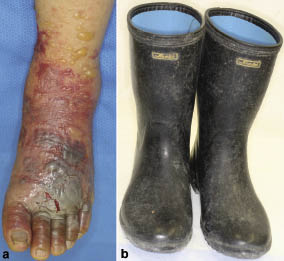Chika Ohata and Mari Yoneda
Department of Dermatology, Ikeda Municipal Hospital, 3-1-18, Jonan, Ikeda, Osaka 563-8510, Japan. E-mail: bboohay02@ybb.ne.jp
Accepted November 16, 2011.
Chika Ohata and Mari Yoneda
Department of Dermatology, Ikeda Municipal Hospital, 3-1-18, Jonan, Ikeda, Osaka 563-8510, Japan. E-mail: bboohay02@ybb.ne.jp
Accepted November 16, 2011.
Dazomet, a soil fumigant, decomposes when it comes into contact with the ground or irrigation water, forming methyl isothiocyanate (MITC), which is effective against many bacteria and fungi. We report here a case of allergic contact dermatitis to dazomet.
CASE REPORT
A 67-year-old male farmer presented with an acute onset of itchy bullae and erythema on his feet. He had a history of diabetes mellitus. On physical examination, multiple bullae and erythema on the left sole, foot, and lower leg were observed, as well as erythema on the right foot (Fig. 1a). Additional bullae developed on the right sole 2 days later. To resolve the severe pruritus and extensive bullae formation prednisolone 20 mg/day was administered for 3 days, followed by 10 mg/day for 10 days. Diflorasone diacetate was used as topical steroid. During the 3 months after steroid cessation, bullae with pruritus occasionally developed on the patient’s feet. Frequent interviews and several laboratory examinations, including skin biopsy, skin cultures, and blood tests, did not reveal the cause. Eventually, the patient’s occupation and the lesion sites led us to suspect his rubber boots (Fig. 1b). Patch tests were performed on the patient’s boots. Thin square pieces (5 × 5 mm) of the outer surface, inner surface, inner insole, and bottom insole of the boots were applied, avoiding pressure effects, on the patient’s back with “Patch Tester Torii” (Torii Pharmaceutical, Tokyo, Japan), an adhesive bandage, for 48 h. Results were obtained after 2 and 3 days of patch test application on the basis of the scoring system by the International Contact Dermatitis Research Group.Positive results were obtained for the outer surface (D2+/D3+), inner surface (D2+/D3+), inner insole (D2++/D3++), and bottom insole (D2++/D3++). Since contact dermatitis was suspected, patch tests with the constituents of the boots, which were rubber chemicals and matrices of the boot material provided by the manufacturer, were subsequently performed. However, all results were negative. Patch tests performed with new but identical boots were also negative. Therefore, we hypothesized that some material absorbed by the rubber boots was the cause of his condition. The patient recalled spraying dazomet in his fields 17 days before the onset of his first symptoms. One week after spraying dazomet, he cultivated the fields wearing his boots. The patient also recalled wearing the boots while spraying other fields 4 days before the onset of symptoms and while working in the fields the following day. Although he washed the boots after each working day, he had worn them for more than 10 h a day before symptom onset and for a few hours a day after cessation of systemic steroids. Gas chromatography analysis of the outer and inner surfaces and the inner and bottom insoles of the boots revealed MITC concentrations of 0.7, 15.6, 16.0, and 11.6 ppm, respectively. These concentrations were equivalent to those of dazomet, i.e. 2, 35, 36 and 26 ppm, respectively. Although the patient had previously used dazomet once every 5 years, this was the first episode of skin eruptions. Patch testing of 10 volunteers with the patient’s boots showed negative results; therefore, a diagnosis of allergic contact dermatitis due to MITC was made.

Fig. 1. (a) Multiple bullae and erythema on the left foot. (b) Patient’s agricultural rubber boots.
DISCUSSION
Dazomet is a white, fine-grained soil fumigant that often falls into farmers’ boots while spraying (1). When the product soaks into the socks, it decomposes to MITC, and a strong irritant reaction with swelling and bullae on the legs and feet can occur (1). In 1991, a dermatitis outbreak occurred among country jail inmates who removed dead fish from the Sacramento River in California, USA, after a spill of metam sodium, which decomposed to MITC in the river (2). This incident indicated that MITC is a strong chemical, primarily causing irritant contact dermatitis. However, allergic contact dermatitis following MITC exposure has also been reported (3). Jay cushions, used by paraplegics and other individuals with disabilities who require wheelchair support, once contained dazomet to extend pad life; however, it was withdrawn following reports of allergic contact dermatitis (4). In our patient, the situation was similar to that observed with the Jay cushion users. The patient’s boots absorbed dazomet (MITC), and he became sensitized to it. Since gas chromatography proved that MITC absorbed by the boots did not disappear despite repeated washing, physicians should consider materials absorbed in shoes or clothing as a possible cause of severe allergic contact dermatitis. The recommended patch test concentration of dazomet is 0.25% (2,500 ppm) aq (the concentration range found in the boots was 2–36 ppm)(5). Compared with this concentration, the concentration of dazomet in the patient’s boots was very low. It is interesting to note that dazomet can elicit an allergic reaction at extremely low concentrations.
The authors declare no conflicts of interest.
REFERENCES
